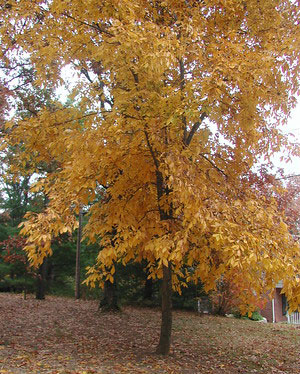Resource Library
Plant of the Week: Carya tomentosa Mockernut Hickory
Fall color is a wonderous thing. The stew of colors from yellows, through oranges and into reds and purples is created by a random assortment of species, each contributing their own shades and hues to the scenes. Hickories primarily fall into the yellow end of the spectrum with mockernut hickory (Carya tomentosa) one of the dozen species found across Arkansas.
Mockernut hickory is a member of the black walnut family. Eighteen species of hickories have been described with a
fourteen or so found in North America and the remainder ranging from China to India.
What are characteristics of a Mockernut hickory?
The Mockernut hickory is a large deciduous tree that ranges from 70 feet tall on a dry upland site to 100 or more in better conditions. It typically is found in drier sites and is part of the oak hickory biome that makes up the Ozark region.
Mockernut has furrowed gray bark and stout, stubby branches. Like all hickories its leaves are arranged alternately down the stem with the terminal wintertime bud large and round to as much as three-quarters inch long. The axillary buds are similar in shape but only about one-third as large as the crown bud.
The compound fragrant leaves are to a foot long with seven to nine sessile leaflets that are deep yellow-green on the upper surface and cloaked in yellow-green to orange-brown hairs on the lower surface. This pubescence on the lower leaf surface is the reason for the specific epitaph. Flowers appear in late spring with male and female parts produced in separate clusters.
The fruit is a four-ridged, thick-shelled nut to an inch long. The name mockernut is from the fact that the tree seems to mock ones’ efforts at eating the kernel held inside the preverbal hard nut to crack. The name hickory is derived from the Algonquian word “pocohicora”, a kind of gruel Native Americans prepared by grinding the oil-rich kernel with the hard, woody shells.
What's the easiest way to identify the Mockernut hickory?
Hickory species have readily identifiable features, and if you are so inclined, can be identified at any season. But, to me at least, identification during the wintertime is perhaps easiest. By looking at the bark and the buds produced during the previous growing season, it is very easy to tell the difference between two common hickories such as mockernut and bitternut hickory.
The mockernut hickory is a tetraploid species with 64 chromosomes, double the number found in most other hickory species. As with many plants with naturally increased chromosome counts, the stout stems, the thick, heavy textured leaves and the hard nut are expressions of the increased ploidy level.
Hickories are favored by foresters for use in furniture making, handles and other applications where a hard, tough wood is required. Mockernut, also called white hickory, is especially prized for furniture manufacturing.
Hickories in the Home Landscape
Hickories are not usually available in the nursery trade. Their deep taproot and slow rate of growth while young makes them unprofitable to grow. But, should they be present in the natural landscape of a home site, they are worth maintaining.
For more information about horticulture or to see other Plant of the Week columns, visit Extension’s Website, www.uaex.uada.edu, or contact your county extension agent. The Cooperative Extension Service is part of the U of A Division of Agriculture.
